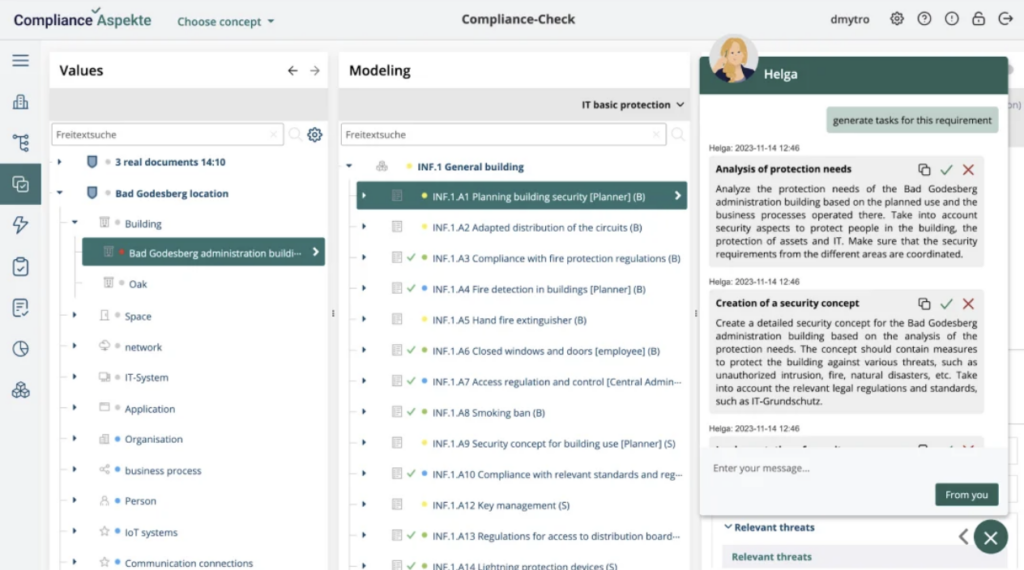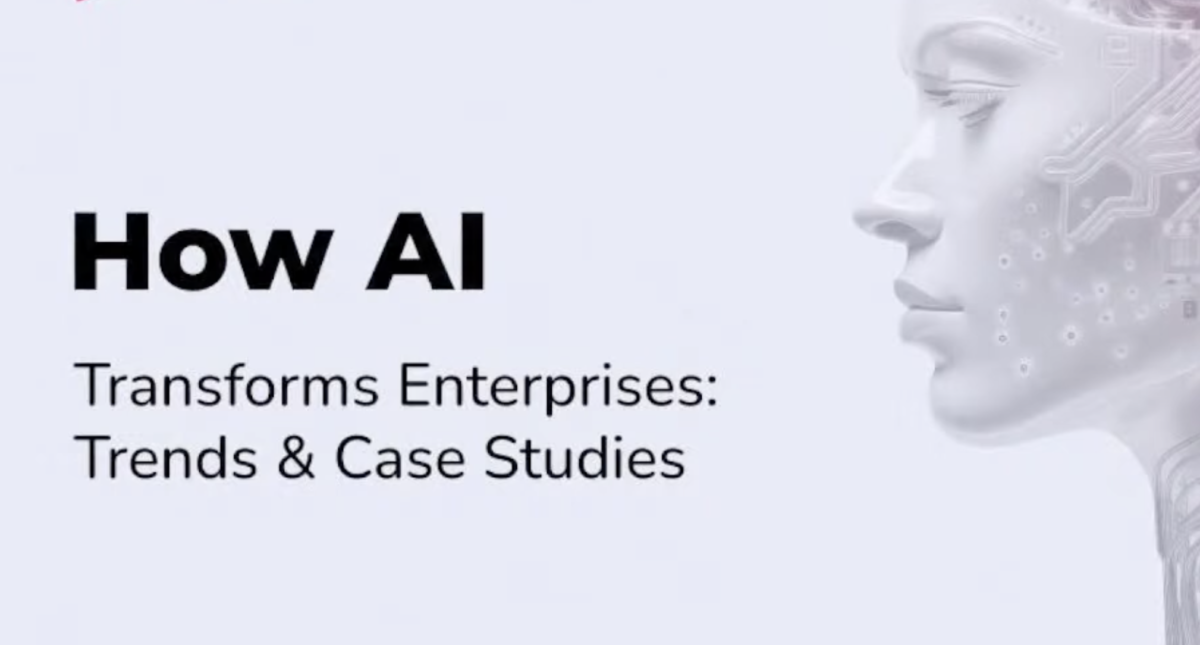AI in the enterprise is transforming the way businesses operate. From data management to cybersecurity and compliance, companies are integrating enterprise AI solutions into key business processes, all with the goals of automating processes, saving costs, introducing MVPs faster, and collecting insights into their operations.
Throughout this guide, we’ll discuss the rationale behind embracing enterprise AI strategy, the impact and challenges of data management for enterprises, and the current trends surrounding GenAI as well as its future trajectory. Additionally, to make our topic practical, we’ll close with two enterprise AI case studies we had at S-PRO that highlight how AI adds value to enterprises.
Why Discuss AI & Enterprises?
In resource-constrained business environments, AI enables companies of all sizes to streamline processes, automate repetitive tasks, and improve operational efficiency. The IBM Global AI Adoption Index shows that 35% of enterprises use AI in operations. Most significantly, 42% of businesses are considering the use of these technologies in the future.
AI in business processes can lead to at least 40% increase in productivity, and 38% increase in profitability and efficiency, thanks to data collection, automation, and cybersecurity.
However, adopting this innovative technology has hurdles, especially for enterprises with large-scale operations, intricate organizational structures, and strict compliance requirements.
But despite these challenges, AI continues to revolutionize the way enterprises work in several key ways, including:
Growing SaaS adoption.
For example, according to a recent study, 67% of enterprise infrastructure is now cloud-based. This represents an industry-wide shift towards SaaS-enabled delivery solutions.
GenAI hype.
>90% of firms will need to modernize to get productivity boost according to Forrester. Gen AI stands to have a profound impact on the pace at which businesses move to the cloud, pushing them to accept more modern infrastructure compatible with AI features that allow them to be more effective and competitive.
This is important because even though companies can easily integrate chatbots, e.g., AI ChatGPT for enterprise, on their platforms, it is nearly impossible to achieve the transformative effect of intricate internal enterprise systems without reorganizing their core infrastructure.
To tackle this challenge, I suggest at the webinar: “There is great hype around Gen AI, and we understand that it’s probably easy to test ChatGPT or another LLM provider. You might create some sort of chatbot integration that doesn’t really affect the very heart of your system. It can be a superficial component, but it will have some impact on your users and bring some value to them. But again, if we want to get some transformative effect and build AI to better understand relations inside the system, the whole architecture of the system probably should be revisited, considering that many enterprises were established around 30 years ago, maybe even earlier.”
Application of AI in new domains.
While artificial intelligence use cases include gaming and social industries, tightly regulated domains like governance, compliance, and data security are only beginning to implement GenAI into their products according to Virtue Market Research.
That said, the potential for these products is immense. Previously, project managers had to undergo extensive training to understand the structure and execution of various standards. However, with AI copilots, the burden is significantly reduced, and the process of ensuring compliance is streamlined.
Data in Enterprises: Challenges and Solutions
Data is the lifeblood of every business. Without data, or more simply, input from users, you cannot build an algorithm for your decision-making processes.
We're not even talking about AI models and machine learning, neural networks and stuff like that. Even if you want to build an algorithm based on heuristics, you still need some data to test your assumptions, to craft those heuristics, and to do some validation, I mentioned during the webinar.
Yet, as critical as data is to enterprises, it also presents significant challenges, several of which we explore in the following section, along with solutions you can implement.
Challenges
Some of the most common data management challenges enterprises face include:
Incompatibility with Legacy Systems
Most enterprise systems running today rely on custom but super obsolete systems like ERP solutions or databases, which are tedious to use, maintain, and update, especially when onboarding new people and approaches to your infrastructure. If we talk about the maintenance of each line of the code, it costs more than $3.5 per line of code, according to recent surveys, which is huge. And the same applies to data.
At this timestamp, I discuss the approaches to data management in legacy systems.
Reliance on Manual Processes
Data cannot exist by itself, so you need mechanisms to extract, process, and send it to analytics. Too often, enterprises are held back because they rely on manual data entry and spreadsheets scattered across different Google Drives or Excel sheets, which are prone to getting outdated and are really hard to manage.
Difficulty Migrating to New and Innovative Technologies
It is difficult for enterprises to migrate to new solutions because the bigger they are, the harder it is to switch to a completely different approach. 90% of enterprises report that legacy systems are limiting their growth and efficiency, especially in sectors like financial services and retail with agile newcomers.
The Shortage of AI Talent
The shortage of trained and experienced AI professionals, particularly in developing countries, hinders the global AI market's growth. To effectively utilize AI systems, the workforce needs expertise in deep learning, machine learning, image recognition, and cognitive computing. Integrating AI technology with existing enterprise systems is complex, requiring significant data processing to emulate human brain functions accurately.
Statista highlights that the scarcity of skilled workers is a significant barrier to AI's broader adoption and business potential. Positions involving data are among the most sought-after and hardest to fill in the AI field. According to Statista, around 25–30% of companies struggle to find and hire qualified data engineers, data scientists, and data architects.
Unpredictable Outcomes
The Black Box problem refers to the difficulty in understanding how deep learning algorithms make decisions. This issue poses a significant challenge to AI market growth, as the results produced by these algorithms can be hard to verify and may contain subtle biases that are not immediately apparent. Consequently, users often lack confidence and security in AI technologies due to the opaque nature of these systems.
To address this issue, enterprises are developing more transparent AI models to mitigate the Black Box effect. Additionally, governments and businesses are establishing research centers and educational programs to tackle the global shortage of AI skills. These efforts are expected to accelerate the growth of the AI industry worldwide.
Solutions
So, how can you approach these problems for your enterprise?
Data Management Platforms
First of all, you need to adopt a standardized and scalable means of managing your data. This centralized data management platform can ingest data from various sources, process it, and feed it through an analytics program to derive insights into your operations and then adapt those insights according to your needs — all in one place. And of course, there are useful ETL pipelines such as Airflow. According to The Brainy Insights, the data warehousing market is to reach USD 85.7 billion by 2032.
Data Governance Frameworks
Data governance involves policies that define how your employees work with data, identify controls and safeguards, and clearly define permissions and data ownership. By embracing proper data governance, you can ease compliance adherence and automate necessary elements like controls, permissions, and security.
However, you cannot simply deploy any program and expect it to work, bringing us to our next point, which is…
Employee Education and Awareness
In addition to adopting new technologies, your company or enterprise must ensure that employees understand how to use them, their roles, and how they can maximize their work time. In short, you need to prioritize education and open communication in your organization.
Cloud Deployments
Even though there are compliance requirements to consider and companies cannot deploy their entire systems in the cloud due to privacy and other reasons, it is a good idea to consider more efficient and scalable solutions, such as the cloud for parts of your system that aren’t subject to extensive compliance regulations.
GenAI: Current State and Future
This section will focus on the Generative AI market, particularly its current state and future outlook, with a special emphasis on AI for enterprises.
Current State
Presently, the GenAI industry is characterized by these enterprise AI trends:
The GenAI industry is experiencing rapid growth, with large language model (LLM) adoption across various enterprise AI use cases. We can see how many new MVPs are built on top of chat GPT emerge in a couple of months. They are getting investments not even roughly comparable to products in other industries.
Accelerated Growth and AI Adoption
LLM (Large Language Model) growth across industries leads to faster development cycles and reduced costs for engineering teams. Products that would take years to implement in 2021 and 2022 now emerge in a few months, meaning it is easier than ever to enter the market with early versions of your products to obtain user validation. For enterprise AI projects, the ability to swiftly iterate and test AI-driven solutions has become a significant advantage. Maybe these AI-driven solutions are not that efficient as custom ones, but at least for the stage of PoC or early MVP it allows your users to provide you feedback.
Rapid Improvements in Image and Video Generation
While videos that match humans’ performance are an ongoing challenge, tools like Midjourney or Sora from OpenAI show promise for broader video AI adoption in the enterprise. The same applies to audio. With models from Meta, MusicGen, and more, we now see that leveraging vast amounts of video and audio data through RAG (Retrieval Augmented Generation) is pushing the boundaries of what's possible, making enterprise AI augmentation more feasible. The abundance of data really makes the difference for AI and allows it to have this significant boost. How it was with ImageNet for computer vision early on, like 10 years ago or so.
Companies and Individuals Want to Benefit from AI
While public awareness of AI is growing, understanding of the privacy and security of AI for large enterprises lags behind. In response, companies like Google and Meta are creating model cards that contain findings about the models they get during research and development. This allows you to understand whether you can leverage an AI tool for your business, considering the data used during training and the biases it might have concerning different user types.
Leveraging AI and LLMs for Enhanced Data Retrieval
In the realm of AI, and specifically Large Language Models (LLMs), one crucial thing is Retrieval-Augmented Generation (RAG). This technique has significantly enhanced the capabilities of chatbots, particularly when integrating with tools like ChatGPT. RAG enables these systems to efficiently retrieve small, relevant sections of documents from extensive knowledge bases, allowing them to accurately answer highly specific questions across various business sectors.
The process begins by connecting AI to your data sources through a method known as embedding. This involves creating vector representations of document segments from the knowledge base. These vectors form a representation that the AI's core LLM can understand, facilitating the retrieval process. By analyzing these embeddings, the AI can determine which pieces of data are most relevant to a user's query, thus providing precise and contextually accurate responses. This innovation not only enhances the usability of AI in customer service and other applications but also opens up new possibilities for leveraging large datasets in meaningful ways.
Growing Need for AI Expertise Across Different Industry Sectors
According to the Stanford AI Index Report 2023, nearly all industries in the US, with the exception of agriculture, forestry, fishing, and hunting, experienced a rise in job postings related to AI in 2022. There is a growing demand from employers for candidates with expertise in artificial intelligence.
The CBI report highlights that the widespread adoption of ChatGPT and other generative AI tools is driving up the need for AI/ML software developers. ChatGPT’s ability to automate tasks such as customer support and content creation, which traditionally required human expertise, has the potential to transform numerous business sectors.
Future
And now to the future of GenAI and a few enterprise AI trends:
Multimodal Generative AI
Multimodal generative AI systems like Gemini and GPT-4 are setting the standard for what it takes to be considered a top LLM. These systems’ transformative feature is that they combine textual input with images, allowing for more versatile interactions and outputs. It isn’t a long shot to imagine solutions of the future capable of recording audio and video, speaking to us using text-to-speech, and processing audio via text-to-speech. These advanced systems enable enterprise AI projects to interact more dynamically with users, offering richer experiences.
Responsible AI
Despite AI legislation being in its early stages, in a year or two, service providers working with data and AI will need to comply with many more responsible AI measures to operate in evolved markets, especially the US and European Union. This shift will likely influence AI adoption in the enterprise, as companies shall prioritize compliance alongside innovation.
The European Union is working on the AI Act to strengthen regulations governing the development and use of AI, addressing ethical concerns and implementation challenges across different industries. Meanwhile, China boasts the most extensive set of AI legislation globally.
More GenAI Providers and State-of-the-art Systems
The landscape of AI for enterprises is expanding, with a surge in both open-source and proprietary models. GenAI is seeing an unprecedented rise in both the number of providers and the “robustness” of solutions. There are a lot of models introduced by various companies or LLM providers that can be customized for specific enterprise AI projects. On one hand, open-source solutions outnumber what we’re seeing from big names like Google and Meta. On the other, state-of-the-art models like GPT4 cannot be deployed on basic GPUs, bringing us to the next trend of…
Compatibility with Everyday Devices
There is a growing movement to compress AI models for deployment on smaller devices like mobile phones, laptops, smartwatches, and TVs. Microsoft's recent paper on Bitnet exemplifies this, where instead of using regular parameters such as floating point numbers, they decided to quantize those parameters to only three possible values: minus one, zero, and one. This development is crucial for enterprise AI augmentation to enable flexible deployment options across different hardware platforms.
LLMops
The emergence of LLMops is specific to GenAI and has already become a recognized job opportunity in the market, particularly for enterprise AI use cases. While the role is largely still being defined, job posts already list responsibilities such as prompt engineering, evaluation of results, LLM selection & deployment, and enterprise machine learning for applications.
How AI Transforms Enterprises: Expert Opinion and Webinar Q&A Session
In S-PRO's recent webinar, “How AI Transforms Enterprises: Trends and Case Studies,” I spoke about the impact of artificial intelligence and the trends across various industries.
A bit about me: I'm Dmytro Voitekh, CTO at S-PRO, an engineering expert and accomplished ML/AI Lead with a profound technical background. I have a track record of success as CTO for a startup focused on EdTech. The startup received multiple rounds of investments, including from Google, just last year. Under my leadership, the startup's estimated value skyrocketed to an impressive $1 million. But that's not all – I frequently give expert talks on machine learning and artificial intelligence at different conferences and workshops, such as FWdays, AI House, Projector, and more.
During the webinar, we also had an engaging Q&A session, where I addressed several thought-provoking questions from the audience.
– How do you foresee the role of GenAI in transforming traditional businesses in the next 5 years?
In the next five years, I foresee GenAI playing a transformative role in traditional businesses, especially in the energy and education sectors. I'm personally really interested in the energy domain, and we've had numerous inquiries from clients about building various modeling engines and simulation mechanisms for the grid. These tools can help with data analysis to identify weak spots, stabilize the grid, and optimize the introduction of new facilities. There's still much to be achieved here, and I'm actively involved in discussions and workshops with industry professionals on how to do this more efficiently.
I'm also fascinated by the potential of AI in education. We've already seen how students use AI to streamline their studies, but there's a gap in GenAI applications from the perspective of teachers and school staff. I believe we're on the cusp of seeing more efficient tools emerge in this area, possibly within the next year. There are already edtech companies adjusting their business models to integrate these innovations. These are just two main areas where I see significant potential for enterprise AI augmentation and AI adoption in enterprises.
– From where to start if we want to build AI capabilities in a big company with a lot of legacy systems processes?
To start building AI capabilities in a large company with many legacy systems, the first step is to clearly define the goals that AI can address. It's crucial to have sessions with stakeholders to pinpoint their pain points and engage in design thinking activities. Understanding the most significant challenges for your business is key to identifying how AI for large enterprises can provide solutions.
Once these goals are established, you need to audit and research your existing systems and infrastructure. This includes evaluating all active components to see how they can integrate with AI solutions or if any need modification. The approach will vary depending on the specific enterprise AI use cases and the depth of integration required.
Typically, you begin with a clarification stage, gathering insights from stakeholders. Then, you move to the ideation phase, brainstorming enterprise AI projects that can address the identified issues. Following this, you develop a proof of concept (POC) to simulate how AI might behave in various scenarios. Working with a solution architect and a business analyst, you can then design the new system and plan an MVP to test in the real world. This process is crucial for successful AI adoption in the enterprise and ensuring that enterprise AI trends are effectively leveraged for enterprise AI augmentation.
– I am looking for a way to store customer data and have the AI craft relevant outputs without being charged for the input and output, since it would become expensive with the amount of customer data. I wonder if there is a cost effective option for this?
For a cost-effective approach to building AI capabilities without incurring high charges for data input and output, especially in AI for large enterprises, it's crucial to consider both the scale of deployment and the specific enterprise AI use cases. Initially, using well-established platforms like ChatGPT can be beneficial for quick experimentation and proof-of-concept (POC) projects. These platforms allow for a rapid understanding of how AI can integrate with your business processes without a significant upfront investment, making them ideal for early-stage enterprise AI projects.
However, as the scale of operations increases, and the number of users grows into the thousands or more, relying on external APIs like OpenAI's can become prohibitively expensive due to the pay-per-use model. Each user interaction adds to the cost, making it difficult to control operational expenses. At this point, it becomes more efficient to consider custom AI deployments. These custom solutions involve using open-source models, which can be fine-tuned for specific enterprise AI trends and needs. Platforms like Hugging Face provide intuitive tools for deploying and managing these models, including options for scaling and model compression to suit varying loads.
Moreover, platforms such as AWS Bedrock offer advanced capabilities for enterprise AI augmentation, including hosting, fine-tuning, and optimizing open-source models for different workflows. This allows enterprises to tailor AI solutions specifically to their unique requirements while maintaining control over infrastructure costs. Custom deployments also offer the flexibility to scale the AI infrastructure according to demand, whether through traditional cloud services like AWS, Azure, or Google Cloud, or through specialized AI hosting services.
Thus, transitioning from external API reliance to custom AI model deployment can provide significant cost savings and efficiency gains. It allows businesses to better manage resources and tailor their AI capabilities to specific enterprise needs, ensuring that the technology serves the business effectively while keeping costs in check. This strategy is useful for companies looking to harness the full potential of AI without incurring unsustainable expenses.
– Do you have examples of data decision system used at the CEO level?
Well, it's a very interesting topic and I've seen a couple of startups recently that I cannot really announce because they are still in stealth mode. But if you have seen Google Duet a couple of months ago, they have introduced a very similar functionality to what I suppose you are talking about, which is helping to automate the role of CEO assistant. So it basically takes into account all your documentation, it takes into account all of the meetings, your calendar, and allows you to more efficiently plan your activities and have some suggestions on how to optimize your daily work. I still have some doubts that even with GenAI and with LLMs, there won't be a need for a manual intrusion into this process.
Because from what I see in my CTO role and other C-level colleagues, it's super subjective from time to time, so AI won't really be able to handle all the intricacies with respect to how to interact with different stakeholders. Because with each of the stakeholders you probably have some specific ways to communicate, collaborate, to validate their results. And maybe there will be a time when AI will be able to handle that in a very personalized and precise way. However, I haven't seen tools like that, even Google Duet from what I see is more like an insights analytics tool rather than something that can just be used as an automation for a CEO.
S-PRO Cases
Now that we’ve explored GenAI trends, let us go over two real-world examples of how AI boosts enterprises regarding usefulness and value for clients.
Compliance Aspekte — AI copilot for GRC
Compliance Aspekte, a leading GRC solution in Europe, empowers companies to manage documents, assess risks, and prepare for compliance certifications like GDPR, ISO 27001, and IT Grundschutz. Before partnering with us, the tool relied on rule-based algorithms and didn’t use AI, and its chatbot was limited in functionality. Our team addressed this by analyzing the firm’s IT architecture, system integrations, and user data, culminating in us developing a new “co-pilot” chatbot. This new version enables users to upload documents, automatically associates documents with compliance requirements, and provides relevant insights and instructions.

TravelPlanBooker — AI solution for the travelling industry
Another example of AI bettering enterprises is our work with TravelPlanBooker. In essence, TravelPlanBooker is the number one platform for stress-free trip planning. Before implementing AI, the platform featured a rule-based approach to receiving user inputs and generating suggestions, making it prone to conflict and scalability issues. To fix this, we implemented generative and conversational AI systems, enabling them to handle abstract queries and offer nuanced travel advice.

For example, imagine you want to visit the Maldives for three weeks with friends and visit as many historical places as possible. You can simply feed this input into the tool. After that, TravelBookerPlanner will create an ideal daily itinerary for you, suggestions on how to best enjoy your time away, activities to do, etc. This AI platform also allows users to make real-time adjustments to their travels.





